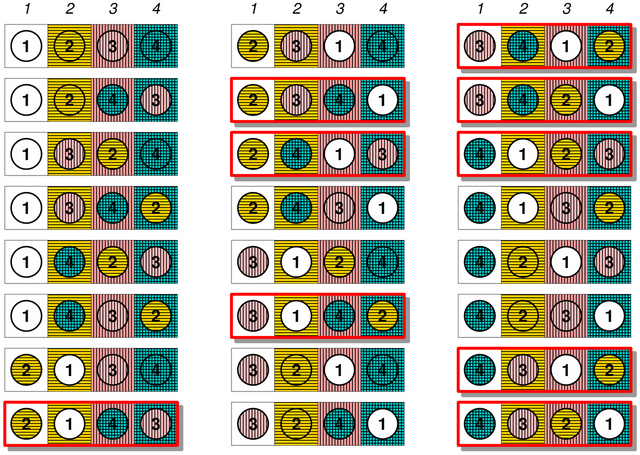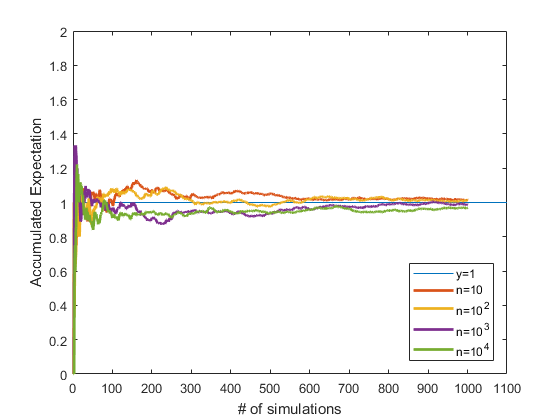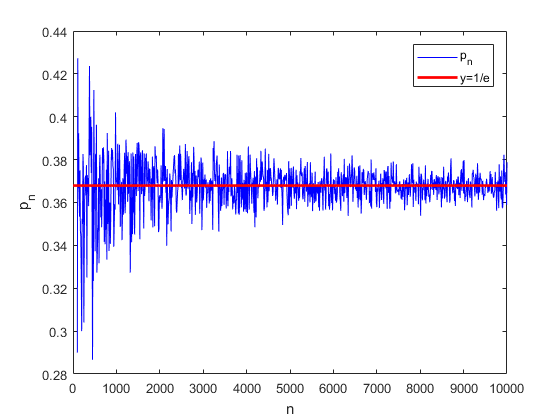[Math Talk #18] Secret of Shuffling - Derangements

[1]
0. What is a Derangement?
In mathematics, permutation is an act of arranging all the members of a set into some sequence or order. A permutation which leaves no element fixed is called a derangement . In many cases, we deal with items (a finite set), each labeled as
So, put another way, a derangement of objects is a permutation of them without fixed points. The number of derangements of
obejcts is usually written as
.
For example, , since singleton set can not have any derangements. Also
, because only derangement is assigning
Let's look at one more example . There are total 2 derangements,
| Element | 1 | 2 | 3 |
|---|---|---|---|
| maps to | 2 | 3 | 1 |
| maps to | 3 | 1 | 2 |
In general, we need to ask the question:
The answer to the question will provide a general formula for as well as
the probability that a permutation of objects is a derangement.
1. Old but Gold Recurrence Relation
Viewing as a sequence
, let's find a recurrence relation for
. Since we already know the value of
and
, let's focus on the values of
for
.
If a permutation
is a derangement, then it must be that , which leaves
possibilities for it. Among those, choose
Now there are two possibilities.
1. If , this is nothing but derangement of
and there are exactly
2. If , this is nothing but derangement of
to
with a restriction . The situation is totally equivalent to derangement of
to
if is viewed as
; so there are exactly
of these.
Since our choice of was arbitrary, summing all those cases gives
Clever trick is to divide both sides by so that
Defining gives
so that
with
2. The other way around
[2]
We've established the formula for derangement, but there is a more intuitive way of relating the total number of permutations with
.
We can count the total ways by partitioning the ways into
disjoint subsets,
where is the set of permutations in which there are exactly
fixed points. If there are
fixed points, we first choose
fixed points among
, and arrange leftovers (
elements) to have no fixed points. This gives
so that
This simple looking relationship is indeed very useful, as we will use in further sections.
3. Expected Number of Fixed points
A rather paradoxical situation arise when we calculate the expeced number of fixed points. Suppose that we perform the experiment of matching the initial arrangement with a random permutation of itself. Define a random variable
as the number of fixed points in single experiment. Then clearly,
can have values
So the expectation is nothing but
In the previous Section, we already obtained the formula for , which is
Now, straightforward calculation gives
Since
by our previous result in Section 3, we get
regardless of .
How should we interpret this weird result? Many of us tend to think the expected number of fixed points will grow as increases. However, the probability of making an element
as a fixed point is
This will help you understand what's going on more clearly. Consider a random variable such that
if
is a fixed point, and 0 otherwise. Then the expectation of number of fixed points is
so that cancel out making the expectation constant; 1.
4. Asymptotic Property of derangement
[3]
Finally, one can ask that
This is nothing but asking the limit
one can easily show that the limit actually exists, and surprisingly, using the well known fact
gives .
Also one can ask that
Recall that we defined random variable as number of fixed points in single random permutation? Using the definition in Section 2 gives
We already proved that , so that
5. Computer Simulation
5-1. Expected number of fixed point revisited
Here is the MATLAB simulation for accumulated expectation of number of fixed points for various . As the number of simulation grows, you can see the accumulated expectation approaches to unity, regardless of
.

5-2. Asymptotic property of Derangement revisited
Now here is the MATLAB simulation for the probability of having derangement in single permutation.

You can see it clearly converges to , oscillating in small region centered
.
6. Conclusion
Number of derangement of
items is equal to
The expectated number of fixed points in single random permutation is 1, regardless of
.
The probability of having derangement converges to
.
7. Citations
[1] Image Source Link, By RokerHRO - Own work, CC BY 3.0
[2] Julian Havil, Nonplussed! Mathematical Proof of Implausible Ideas. Chapter 5 page 53
[3] Julian Havil, Nonplussed! Mathematical Proof of Implausible Ideas. Chapter 5 page 56
MATLAB plots are self-made.
Congratulations @mathsolver! You have completed the following achievement on Steemit and have been rewarded with new badge(s) :
Click on the badge to view your Board of Honor.
If you no longer want to receive notifications, reply to this comment with the word
STOPThis post has been voted on by the steemstem curation team and voting trail.
There is more to SteemSTEM than just writing posts, check here for some more tips on being a community member. You can also join our discord here to get to know the rest of the community!
Hi @mathsolver!
Your post was upvoted by utopian.io in cooperation with steemstem - supporting knowledge, innovation and technological advancement on the Steem Blockchain.
Contribute to Open Source with utopian.io
Learn how to contribute on our website and join the new open source economy.
Want to chat? Join the Utopian Community on Discord https://discord.gg/h52nFrV